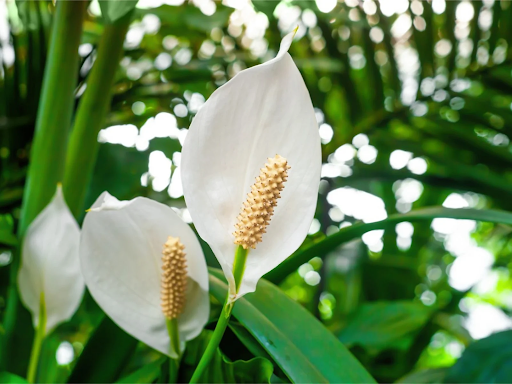In the vast tapestry of botanical wonders, the Spathiphyllum, commonly known as the Peace Lily, stands out as a symbol of grace, purity, and resilience. With its lush green foliage and elegant white blooms, this tropical beauty has become a favourite among plant enthusiasts and interior decorators alike. In this article, we’ll delve into the world of Spathiphyllum, exploring its origins, unique characteristics, care requirements, and the symbolic significance that has made it a cherished addition to homes and offices worldwide.
1. Origins and Natural Habitat
The Spathiphyllum is native to the rainforests of Central and South America, where it thrives in the dappled shade beneath the dense canopy. This tropical perennial, a member of the Araceae family, has adapted to the low light conditions of its native environment, making it well-suited for indoor cultivation. The plant’s ability to flourish in the understory of rainforests has translated into its resilience and adaptability as a popular houseplant.
2. Distinctive Features
One of the most striking features of the Peace Lily is its foliage. The leaves are glossy, dark green, and lance-shaped, creating a lush and vibrant display even in low-light settings. The characteristic white blooms, often mistaken for petals, are actually modified leaves called spathes that surround the central spadix. This unique floral structure adds to the plant’s allure, giving it an elegant and sophisticated appearance.
3. Air Purification Abilities
Beyond its aesthetic appeal, the Peace Lily is celebrated for its air-purifying qualities. This plant has been proven to filter and clean indoor air by removing common pollutants such as benzene, formaldehyde, and ammonia. The Peace Lily’s ability to enhance air quality makes it a popular choice for homes and offices, contributing to a healthier and more pleasant living or working environment.
4. Care Requirements
Caring for a Spathiphyllum is relatively straightforward, making it an excellent choice for both novice and experienced plant enthusiasts. Here are some key care considerations:
Humidity: The Peace Lily appreciates higher humidity levels. Misting the plant occasionally or placing it on a tray filled with water and pebbles can help create a more humid microenvironment.
Temperature: Spathiphyllum thrives in average room temperatures between 65-80°F (18-27°C). Avoid exposing it to drafts, as the plant prefers stable conditions.
Fertilisation: Feed the Peace Lily with a balanced, water-soluble fertiliser every 6-8 weeks during the growing season (spring and summer). Reduce or eliminate fertilisation during the dormant period in fall and winter.
5. Symbolic Significance
The Peace Lily holds symbolic meaning across various cultures. True to its name, the plant is associated with peace, tranquillity, and harmony. It is often chosen as a thoughtful gift during times of mourning or as a gesture of sympathy. In Feng Shui, the Peace Lily is believed to attract positive energy and prosperity, making it a popular choice for homes and businesses seeking balance and auspicious vibes.
6. Varieties and Hybrids
The popularity of the Peace Lily has led to the development of various varieties and hybrids. Some notable cultivars include the compact “Domino,” featuring variegated foliage, and the larger “Sensation,” known for its striking, dark green leaves. These variations offer plant enthusiasts a range of options to suit different preferences and space constraints.
7. Challenges and Solutions
While the Peace Lily is generally hardy, it can face challenges such as pest infestations, particularly from spider mites and aphids. Regularly inspecting the plant and treating any issues promptly with insecticidal soap or neem oil can help maintain its health. Additionally, overwatering is a common pitfall, so it’s crucial to strike a balance and ensure proper drainage. Looking for a plant shop in Australia, consider “The Jungle Collective”.
Conclusion
The Spathiphyllum, or Peace Lily, stands as a testament to the beauty and resilience found in the natural world. Its elegant foliage, delicate blooms, and air-purifying abilities have elevated it to a position of prominence in homes, offices, and symbolic rituals around the globe.





